
|
Eleonore Wenzel began her life as the daughter of a miner in Freiberg, a city in Saxony located 40 miles northeast of Annaberg on the road to Dresden. Considered the cradle of mining in the Erzgebirge, Freiberg received its name — “free mountain”— because its mining charter, enacted shortly after silver was first discovered there in 1168, granted free prospecting rights to anyone. By 1800 the city had a proud heritage of mining and trade, a technical university, and a population of about 20,000.
Johann Salomo Wenzel and Johanna Dorothea (née Ott) christened their first and only child Johanna Dorothea Eleonore shortly after her birth on September 20, 1805. The pious couple taught their daughter the rudiments of their faith in her early childhood. That proved to be their legacy to her, for when she was just seven years old, Eleonore was left an orphan during the chaos of the Napoleonic Wars that were raging through Europe. In alliance with the French, Saxony had some 20,000 men fighting in Napoleon’s Grand Armee. Bonaparte himself led his troops through Freiberg in 1812 en route to his disastrous invasion of Russia. The following year, the Battle of Leipzig was fought just 65 miles away. There Napoleon was defeated in the largest conflict of the war, in which a staggering 600,000 soldiers fought and 90,000 died. Victorious Sixth Coalition forces under Prussian General Blücher occupied Freiberg. The occupation and siege inflicted misery and hardship on the local population; and the troops quartered throughout the area spread deadly epidemics (such as typhus), which killed large numbers of adults in Freiberg, among them Eleonore’s parents. Eleonore was put in an orphanage, where she endured rough treatment from the tyrannical matron. The orphan population in Freiberg continued to grow precipitously, until finally the city — lacking the resources to care for so many children — loaded them onto wagons and drove them to cities and towns outside the stricken area in the hopes of finding them sustenance. Eleonore’s wagon stopped in the industrial city of Annaberg, where she was taken into the house of Johann Korb, a silk merchant and lottery agent. The Korbs did not adopt Eleonore as a daughter, but rather added her to their household as a kind of servant. They provided her with basic care, a good upbringing, and schooling consistent with the times. Her foster parents were not religious people, but Eleonore was confirmed according to the general custom. The Korbs treated her strictly but fairly, and thus “Eleonore Korb,” as she was then known, grew to adulthood. When she was about 20, Eleonore moved next door to work for Carl Gottlob Wiederänders, a 38-year-old master cooper. She kept house and took care of his infant son, whose mother had died in childbirth. She might also have nursed Carl’s second wife, who died childless in early 1828. Around that time Carl sought comfort in Eleonore’s bed. Their first son, Carl Anton, was born November 29, 1828. Eleonore and Carl were married on March 1, 1829. Carl Anton’s birth was followed by that of Carl Gustav in 1831 and Carl Ernst in 1833. Ernst was a weak, delicate child from birth. Johanna, their first daughter (born circa 1835), had a severe illness in infancy that left her physically impaired and unable to walk. Another sickly child, Carl Hermann, was born next. These were difficult years for Eleonore, with a household to run and three of her six children requiring constant care. She teetered on the edge of exhaustion, relying on her faith for moral support. A healthy daughter, Eleonore Wilhelmina (called Minel) was born in 1837. Around 1841, Hermann and then Johanna died in quick succession. Meanwhile, Ernst’s condition gradually improved. Two more sons were added to the family: Carl Emil (1841) and Carl Eduard (1842). A daughter, Therese, was born in 1846 but died in infancy. Of Eleonore’s nine children, three died in early childhood and only three outlived her. Eleonore struggled constantly to make ends meet and feed her large family. The house was burdened by a heavy mortgage, and harsh economic conditions made it impossible for her husband to earn a good living. Butter beans were a staple of the family’s diet, according to a letter written much later by a friend of Gottlob who fondly remembered Eleonore’s generosity with that legume. A landlady as well, she had to deal with the four different tenant families who shared her large house. She was also plagued by a difficult relationship with Carl’s sister, who “caused her much grief.” The Wiederänders home — bursting at the seams with children and their playmates, apprentices, and tenants — was a merry and hospitable place despite the hard times. Of the boys’ adventures sleeping in the attic, Emil later wrote in his diary: “Every night cats would make a terrible racket between the attic ceiling and the roof. One night Anton grabbed one of the cats by the tail and threw it out the window. The pavement was about 65 feet below. We thought for sure the fall would kill the cat, but it landed on its feet and, as a dog charged it, the cat ran away.” And the butter bean recipient (named Anton) wrote: “There is something my stomach would like to experience again: dunking doughnuts in coffee with you as I did untold times at your good parents’ home, when I had the great fortune to be included in your family circle around the table.” [Roland P. Wiederaenders added the following editorial comment in 1967: “Excellent fellow, this Anton! He recognized and appreciated the delight of dunking doughnuts. And where did he learn this? In a Wiederänders home! The art of dunking has a long and glorious history in the Wiederänders family. Let no one discourage the development of the finer techniques of this art in our time.”] Around 1847, the family’s situation grew so dire that they began to consider emigrating. Carl’s four older sons supported the idea wholeheartedly. It took the Wiederänders seven years to put their plan into action — they had to gather sufficient resources, and Carl also had to secure their sons’ release from military obligation. In 1854 the family endured a 13-week journey from Annaberg to Round Top, Texas, where they began the arduous process of establishing a new life. While their older sons dispersed to find work, Eleonore and Carl moved with their youngest son Eduard to the wilderness outside Round Top to help their daughter Minel (now 17) and her new husband, John Renker, clear land and build a homestead on Rabbs Creek. The family had scarcely been in Texas a year when the first tragedy struck. Carl Anton, Eleonore’s first child, died of a high fever (probably malaria) in August of 1855. He was 26. Seven weeks earlier, her youngest son Eduard, then 12, had ridden away with a Dutch farmer who wanted the boy to live on his farm and teach his sons German. After Eduard left, his parents realized they had no idea how to get in touch with him. Eleonore’s constant refrain became “Anton is dead, and who knows what has become of Eduard?” She was overjoyed when the boy reappeared, but any consolation was shattered a few weeks later by the sudden death of her husband. Carl, 68, succumbed to a stroke on September 28, 1855, after being weakened by a fever. Widowed at age 50, Eleonore stayed with friends and her daughter for two years, then went to keep house for Ernst and Eduard, who had a year’s contract working for a farmer in the area. They lived in an empty house on the farm. When the year was up Gustav and Emil joined them there to work some land that the two oldest sons had leased from the farmer. Eleonore was deeply gratified to have her four remaining sons reunited with her under one roof. But their trials were far from over. In the course of the year, Eleonore began to suffer intense chronic pain from rheumatism, while Eduard contracted typhus and hovered near death. And in June 1859, Ernst died of peritonitis at the age of 25. Again her sons scattered. Gustav married and bought land on Rabbs Creek, and Eleonore lived with them. Emil and Eduard (now Edward) returned to Round Top, where they eventually began a work-study program at a new seminary. Then the Civil War broke out, and in the spring of 1862 all able-bodied men between the ages of 18 and 35 were drafted into the Confederate Army. Gustav, Edward, and Minel’s husband John Renker were all forced into service. (Emil, who had become a teacher, was exempt.) Eleonore moved in with Minel, who by that time had four small children. Somehow the two women, like so many others, managed to get through the desperate war years. They watched helplessly as the farm fell into ruins around them. After three years their dwelling was so decrepit that it was almost uninhabitable. The fields lay neglected and weed-choked, and the fences had rotted to pieces, allowing the neighbors’ cow to roam freely through the peach orchard. Of their three men who had gone off to war, only one came back. Gustav, at 32, fell in battle in 1864 in Arkansas. John Renker died near Laredo, Texas — most likely of fatigue and privation — while patrolling the border between Texas and Mexico. Edward returned in 1865, but with his health permanently damaged. Since arriving in the new country in 1854, Eleonore had lost her husband and three eldest sons. She now had only her three youngest children left. She and Edward, by then 22 years old, stayed on at Minel’s farm while Edward restored it to working condition, which took an entire year. Minel remarried, and Eleonore and Edward moved north to join Emil, who was now a minister in Prairie du Chien, Wisconsin. They traveled by buggy from Round Top to Brenham, then by rail to Galveston, and by steamboat across the Gulf of Mexico and up the Mississippi River — a four-week journey. The remainder of Eleonore’s life was peaceful, and easier by far than her twelve turbulent years in Texas. For several years she lived with Emil and his wife. When Edward married in 1872, she made her home with him until the end of her days. On June 9, 1877, at the age of 71 years, Eleonore died peacefully in Boscobel, Wisconsin. © Julia Moore, 2006. All rights reserved. Sources: “A Brief Sketch of My Mother’s Life,” from A Part of the History of the Wiederaenders Family, as written down (in German) by Edward Wiederanders. Bernhard, Marianne, Die Silberstrasse und ihre Geschichte, Sachsenbuch Verlagsgesellschaft, 1992 Wikipedia, search for “Napoleonic Wars,” accessed April 14, 2006. |
Click on pictures to enlarge
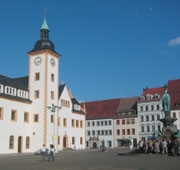 Freiberg, Saxony: The Rathaus (City Hall) and market square 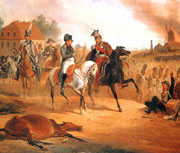 Napoleon and Poniatowski at the Battle of Leipzig  Funeral procession for a miner in 19th century Freiberg 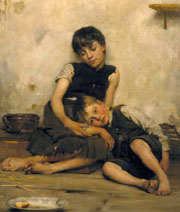 Orphans 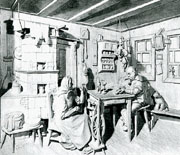 A typical miner’s cottage, mid-19th century 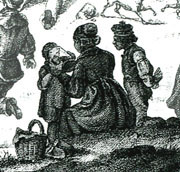 A mother and her children at an outdoor guild festival. 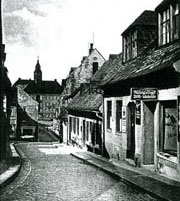 Annaberg: “Upper Smiths’ Lane” leading down to the marketplace 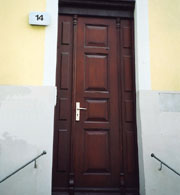 The front door of the former Wiederänders residence in Annaberg  Interior of a German family’s home in 1840 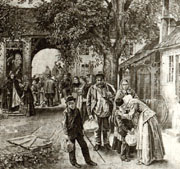 The emigrants’ farewell to their homeland  Log cabin in Serbin, Texas 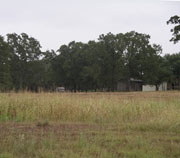 A farm near Rabbs Creek, between Round Top and Serbin 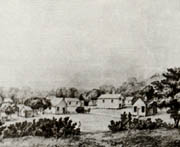 The settlement of Round Top 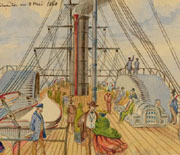 Steamboat journey on the Mississippi River 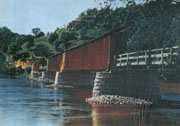 Covered bridge in Boscobel, Wisconsin. |